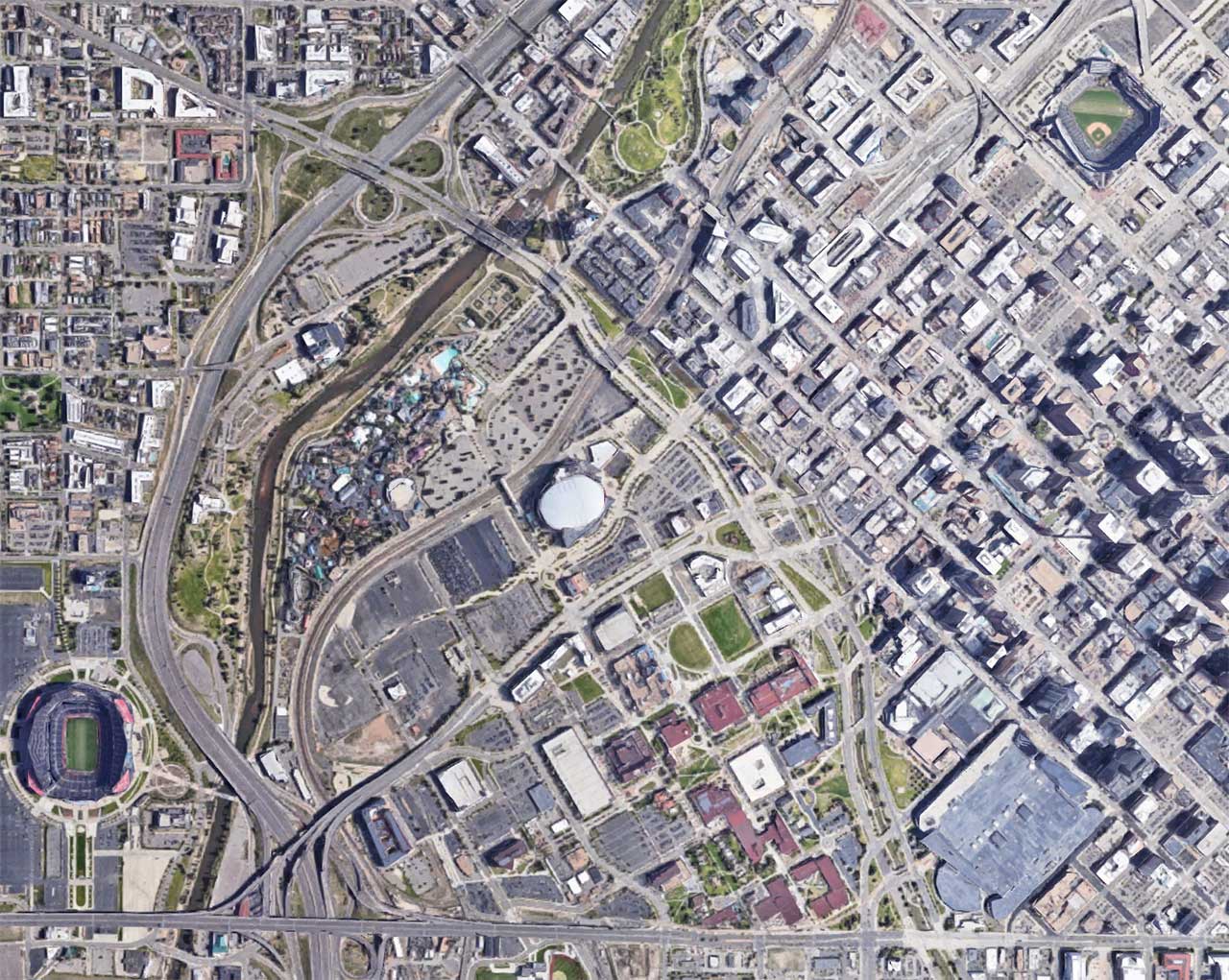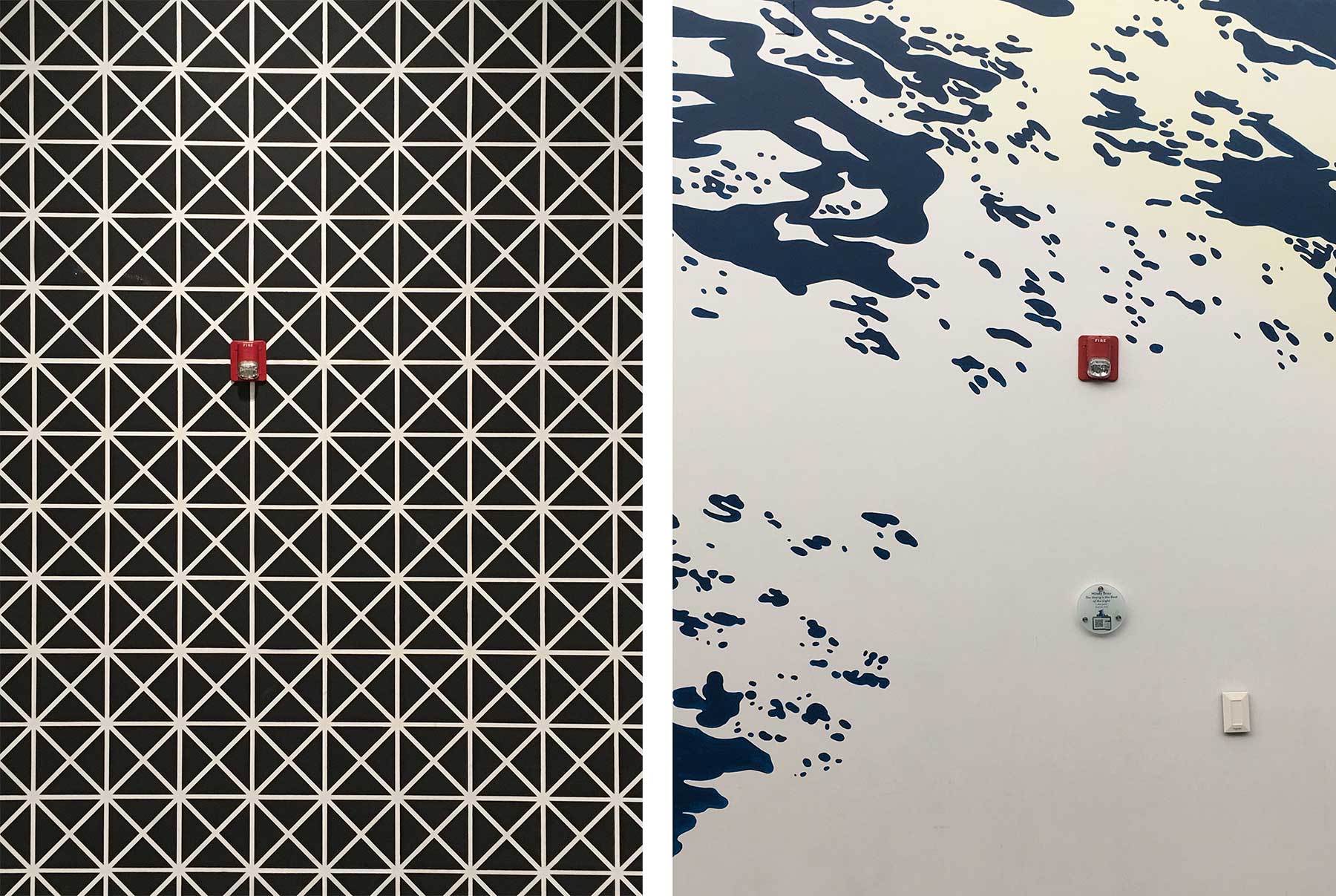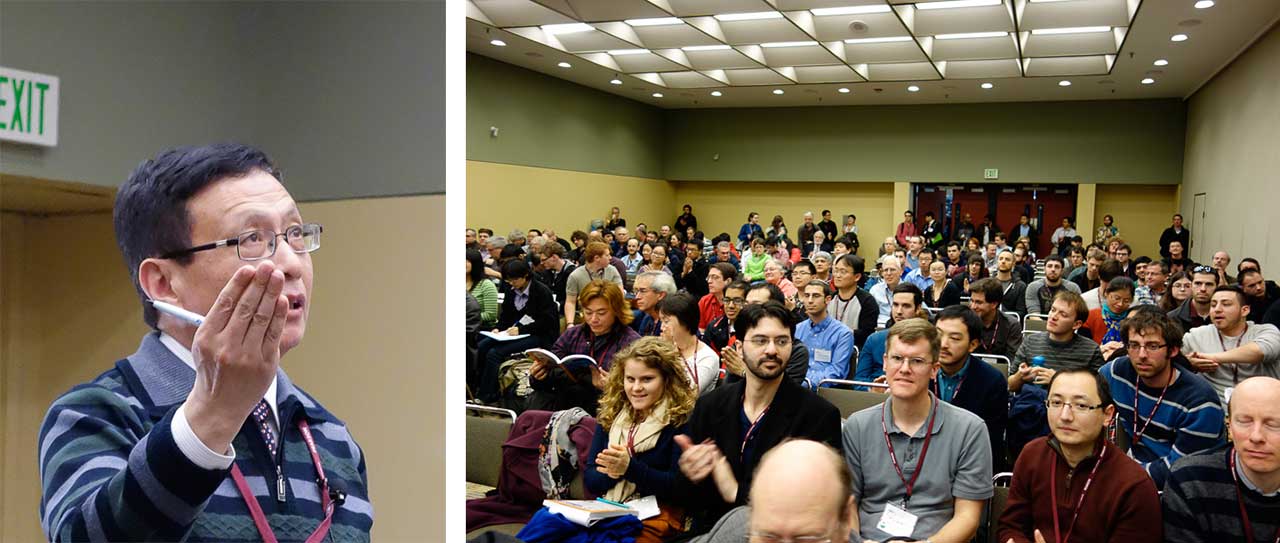In January I went to the Joint Mathematics Meetings, which were held in Denver for the first time ever. The main venue was the Colorado Convention Center, a building whose roof area, by my rough estimate, is well above a million square feet. Inside I found acres of patterned carpet, enough folding stacking

The Colorado Convention Center is the dark gray blob at lower right. Based on a perusal of Google Maps, it appears to be the largest single roof in the city of Denver, and it would remain so even if the football stadium (lower left) or the baseball stadium (upper right) had a roof.
Wandering around in these cavernous spaces always leaves me feeling a little disoriented and dislocated. It’s not just that I’m lost, although often enough I am—searching for Lobby D, or Meeting Room 407, or a toilet. I’m also dumbfounded by the very existence of these huge empty boxes, monuments to the human urge to congregate. If you build it, we will come.
It seems every city needs such a place, commensurate with its civic stature or ambitions. It’s no mystery why the cities make the investment. The JMM attracted more than 5,500 mathematicians (plus a few interlopers like me). I would guess we each spent on the order of $1,000 in payments to hotels, restaurants, taxis, and such, and perhaps as much again on airfare and registration fees. The revenue flowing to the city and its businesses and citizens must be well above $5 million. Furthermore, from the city’s point of view it’s all free money; the visitors do not send their children to the local schools or add to the burden on other city services, and they don’t vote in Denver.
However, this calculation tells only half the story. Although visitors to the Colorado Convention Center leave wads of cash in Denver, at the same time Denver residents are flying off to meetings elsewhere, withdrawing funds from the local economy and spreading the money around in Phoenix, Seattle, or Boston. If the convention-going traffic is symmetrical, the exchange will come out even for everyone. So why don’t we all save ourselves a lot of bother—not to mention millions of dollars—and just stay home? From inside the convention center, you may not be able to tell what city you’re in anyway.

Convention centers are not really all alike—not as much as Walmarts or Home Depots. In Denver some large-scale artwork caught my eye. I particularly admire the little red box that serves as a unifying element, like Harold’s purple crayon. Left: Detail of “I Know You Know That I Know,” by Sandra Fettingis. Right: Detail of “The Heavy is the Root of the Light,” by Mindy Bray.
While I was in Denver, I looked at the schedule of upcoming events for the convention center. A boat show was getting underway even as the mathematicians were still roaming the corridors, and tickets were also on sale for some sort of motorcycling event. The drillers and frackers were coming to town a few weeks later, and then in March the American Physical Society would hold its biggest annual gathering, with about twice as many participants as the JMM. The APS meeting was scheduled for this week, Monday through Friday (March 2–6). But late last Saturday night the organizers decided to cancel the entire conference because of the coronavirus threat. Some attendees were already in Denver or on their way.
I was taken aback by this decision, which is not to say I believe it was wrong. A year from now, if the world is still recovering from an epidemic that killed many thousands, the decisionmakers at the APS will be seen as prescient, prudent, and public-spirited. On the other hand, if Covid-19 sputters out in a few weeks, they may well be mocked as alarmists who succumbed to panic. But the latter judgment would be a little unfair. After all, the virus might be halted precisely because those 11,000 physicists stayed home.
I have not yet heard of other large scientific conferences shutting down, but a number of meetings in the tech industry have been called off, postponed, or gone virtual, along with some sports and entertainment events. The American Chemical Society is “monitoring developments” in advance of their big annual meeting, scheduled for later this month in Philadelphia. [Update: On March 9 the ACS announced "we are cancelling (terminating) the ACS Spring 2020 National Meeting & Expo."] Even if the events go on, some prospective participants will not be able to attend. I’ve just received an email from Harvard with stern warnings and restrictions on university-related travel.
Presumably, the Covid-19 threat will run its course and dissipate, and life will return to something called normal. But it’s also possible we have a new normal, that we have crossed some sort of demographic or epidemiological threshold, and novel pathogens will be showing up more frequently. Furthermore, the biohazard is not the only reason to question the future of megameetings; the ecohazard may be even more compelling.
All in all, it seems an apt moment to reflect on the human urge to come together in these large, temporary encampments, where we share ideas, opinions, news, gossip—and perhaps viruses—before packing up and going home until next year. Can the custom be sustained? If not, what might replace it?
Mathematicians and physicists have not always formed roving hordes to plunder defenseless cities. Until the 20th century there weren’t enough of them to make a respectable motorcycle gang. Furthermore, they had no motorcycles, or any other way to travel long distances in a reasonable time.
Before the airplane and the railroad, meetings between scientists were generally one-on-one. Consider the sad story of Neils Henrik Abel, a young Norwegian mathematician in the 1820s. Feeling cut off from his European colleagues, he undertook a two-year-long trek from Oslo to Berlin and Paris, traveling almost entirely on foot. In Paris he visited Lagrange and Cauchy, who received him coolly and did not read his proof of the unsolvability of quintic equations. So Abel walked home again. Somewhere along the way he picked up a case of tuberculosis and died two years later, at age 27, impoverished and probably unaware that his work was finally beginning to be noticed. I like to think the outcome would have been happier if he’d been able to present his results in a contributed-paper session at the JMM.
For Abel, the take-a-hike model of scholarly communication proved ineffective; perhaps more important, it doesn’t scale well. If everyone must make individual tête-à-tête visits, then forming connections between \(n\) scientists would require \(n(n - 1) / 2\) trips. Having everyone converge at a central point reduces the number to \(n\). From this point of view, the modern mass meeting looks not like a travel extravagance but like a strategy for minimizing total air miles. Still, staying home would be even more frugal, whether the cost is measured in dollars, kelvins, or epidemiological risk.
Most of the big disciplinary conferences got their start toward the end of the 19th century, and by the 1930s and 40s had hundreds of participants. Writing about mathematical life in that era, Ralph Boas notes: “One reason for going to meetings was that photocopying hadn’t been invented; it was at meetings that one found out what was going on.” But now photocopying has been invented—and superseded. There’s no need for a cross-country trip to find out what’s new; on any weekday morning you can just check the arXiv. Yet attendance at these meetings is up by another order of magnitude.
Even in a world with faster channels of communication, there are still moments of high excitement in the big convention halls. At the 1987 March meeting of the APS, the recent discovery of high-temperature superconductivity in cuprate ceramics was presented and discussed in a lively session that lasted past 3 a.m. The event is known as the Woodstock of Physics. I missed it—as well as the original Woodstock. But I was at the JMM in 2014 when progress toward confirming the twin prime conjecture caused a big stir. The conjecture (still unproved) says there are infinitely many pairs of prime numbers, such as 11 and 13, separated by exactly 2. Yiting Zhang had just proved there are infinitely many primes separated by no more than 70 million. Several talks discussed this finding and followup work by others, and Zhang himself spoke to a packed room.

Yiting Zhang and his audience.
Boas emphasized the motive of hearing what’s new, but one must not ignore the equally important impulse to tell what’s new. At the recent JMM, with its 5,500 visitors, the book of abstracts listed 2,529 presentations. In other words, almost half the visitors came to deliver a talk, which is probably a stronger motivation than hearing what others have to say. (When I first saw those numbers, I had the thought: “So, on average every presentation had one speaker and one listener.” The truth is not quite as bad as that, but it’s still worth keeping in mind that a meeting of this kind is not like a rock concert or a football game, with only a dozen or so performers and thousands in the audience.)
At some gatherings, the aim is not so much to talk about math and science but to do it. Groups of three or four huddle around blackboards or whiteboards, collaborating. But this activity is commoner at small, narrowly focused meetings—maybe at Aspen for the physicists or Banff for the mathematicians. No doubt such things also happen at the bigger meetings, but they are not a major item on the agenda for most attendees.
For one subpopulation of meeting-goers the main motivation is very practical: getting a job. Again this is a matter of efficiency. Someone looking for a postdoc position can arrange a dozen interviews at a single meeting.
There are many reasons to make the pilgrimage to the Colorado Convention Center, but I think the most important factor is yet to be stated. Dennis Flanagan, who was my employer, friend, and mentor many years ago at Scientific American, wrote that “science is intensely social.”
Flanagan’s Version, 1988, p. 15. In an active scientific discipline everyone knows everyone else, if not in person, then by their writings and reputation. Scientists attend at least as many meetings and conventions as salesmen.
You might interpret this comment as saying that scientists—like salesmen—are a bunch of genial, gregarious party animals who like to go out on the town, drink to excess, and misbehave. But I’m pretty sure that’s not what Dennis had in mind. He was arguing that social interactions are essential to the process of science. Becoming a mathematician or a physicist is tantamount to joining a club, and you can’t do that in isolation. You have to absorb the customs, the tastes, the values of the culture. For example, you need to internalize the community standard for deciding what is true. (It’s rather different in physics and mathematics.) Even subtler is the standard for deciding what is interesting—what ideas are worth pursuing, what problems are worth solving.
Meetings and conferences are not the only way of inculcating culture; the apprenticeship system known as graduate school is clearly more imporant overall. Still, discipline-wide gatherings have a role. By their very nature they are more cosmopolitan than any one university department. They acquaint you with the norms of the population but also with the range of variance, and thereby improve the probability that you’ll figure out where you fit in.
The quintessential big-meeting event is running into someone in the hallway whom you see only once a year. You stop and shake hands, or even hug. (In future we’ll bump elbows.) You’re both in a hurry. If you chat too long, you’ll miss the opening sentences of the next talk, which may be the only sentences you’ll understand. So the exchange of words is brief and unlikely to be deep. As I and my cohort grow older, it often amounts to little more than, “Wow. I’m still alive and so are you!” But sometimes it’s worth traveling a thousand miles to get that human validation.
If we have to dispense with such gatherings, science and math will muddle through somehow. We’ll meet more in the sanitary realm of bits and pixels, less in this fraught environment of atoms. We’ll become more hierarchical, with greater emphasis on local meetings and less on national and international ones. The alternatives can be made to work, and the next generation will view them as perfectly natural, if not inevitable. But I’m going to miss the ugly carpet, the uncomfortable folding/stacking chairs, and the ballrooms where nobody dances.